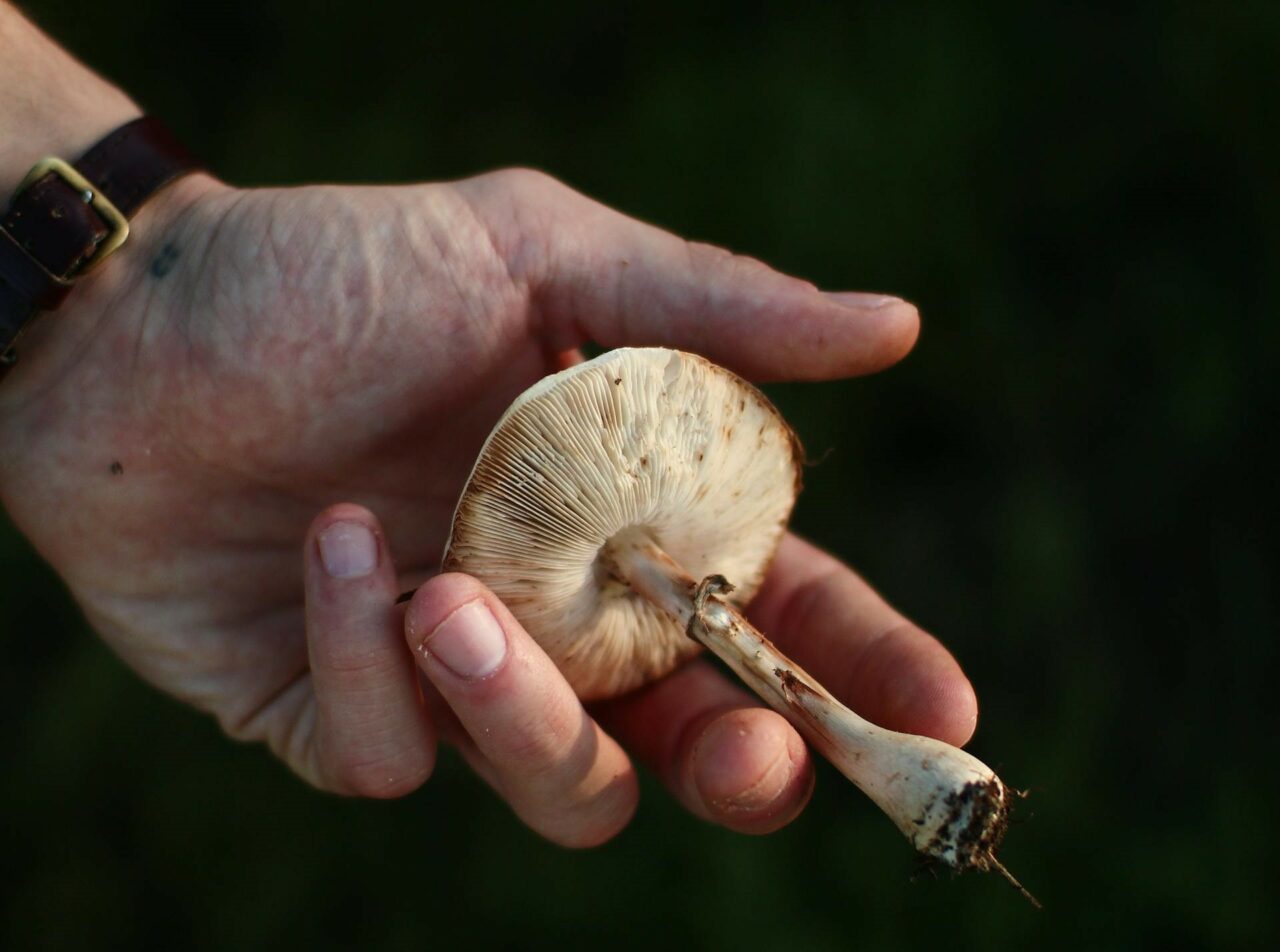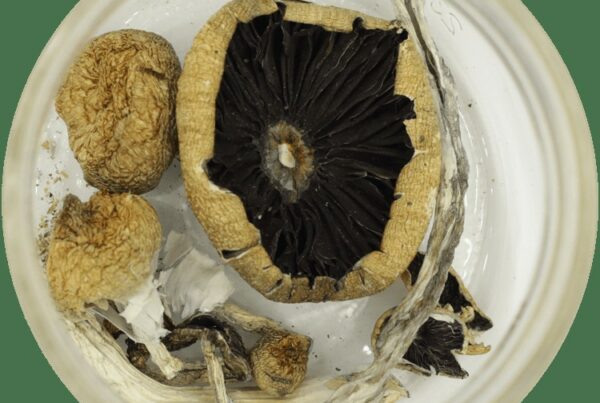Psilocybin mushrooms, akin to LSD in their role as a serotonin 5-HT2A receptor agonist, are a traditional form of psychedelic. Presently, these mushrooms are under investigation for their potential benefits in psilocybin-assisted therapy for various mental health issues, such as severe depression, anxiety, cluster headaches, and migraines.
To understand the role of shrooms in treating these conditions, it is essential to study their metabolic process in the body. This knowledge will enable both researchers and users to comprehend how the active compound produces psychological and therapeutic impacts. This article presents a basic understanding of the pharmacology and pharmacokinetics of psilocybin.
[toc]
Key Takeaways:
- When ingested orally, half of the psychedelic fungi is absorbed and distributed across the body.
- The fungal compound undergoes dephosphorylation through the enzyme alkaline phosphatase, primarily in the liver.
- Around 3.4% of the compound is eliminated in its original form within 24 hours, with the rest mainly expelled as a stable metabolite.
What is Pharmacokinetics?
Pharmacokinetics (PK) is the field of study that focuses on how substances like drugs are processed by the body after ingestion. Although related, it is different from pharmacodynamics, which is the study of how a compound interacts with the body. PK primarily focuses on four aspects: absorption, distribution, metabolism, and excretion (ADME).
This understanding facilitates healthcare providers in prescribing the most effective medications with the least possible risk. It also helps them to adapt treatments according to each patient’s unique physiological and lifestyle needs.
How Does Pharmacokinetics Relate to Psilocybin?
Psilocybin and psilocin, the main active components in certain types of magic mushrooms, have piqued substantial interest among researchers and users. Pharmacokinetics explores how the body processes mushrooms containing psilocybin, aiding in understanding their potential effects, be it medicinal or recreational.
These compounds are known by various names, such as “magic,” “psychedelic,” “medicinal,” or “sacred.” The fungi containing these compounds are consumed, and The varieties of mushrooms, their place of origin, size, the environment in which they grow and dry, and their age can all contribute to substantial differences in their concentrations.
While these mushrooms naturally exist in the wild, scientists have devised ways to artificially produce them in a laboratory. Both the natural and lab-grown versions have low toxicity, although minor side effects such as nausea or vomiting may occur.
Despite these physical impacts, the compounds in these mushrooms have demonstrated potential therapeutic benefits due to their safe profile and non-addictive characteristics. These advantages have prompted researchers to explore their application in psychotherapy, specifically for treating anxiety and depression.
The 4 Phases of Pharmacokinetics
Psilocybin, the compound present in these mushrooms, is inactive in its initial state and functions as a prodrug, turning into its active form, psilocin. Enzymes such as alkaline phosphatase facilitate this conversion, enabling psilocin to be absorbed and distributed throughout the body, reaching a variety of tissues. However, after oral intake, psilocybin cannot be traced in the circulatory system, feces, or urine.
Absorption
Absorption is the process by which the compound enters the bloodstream from the point of administration. It plays a crucial role in determining the rate and effectiveness of the compound reaching its target, such as the plasma. Oral consumption is the most common method of administration. Inhalation has been tried, but it has proven less effective than oral intake.
The absorption procedure also includes the release of the compound from the dosage form during oral intake. Factors like a delay in the throat or esophagus can affect this process, potentially delaying results or causing discomfort. Once the compound arrives in the stomach, the acidic environment may start to degrade it before it enters the bloodstream.
Studies on animals suggest that only around 50% of orally administered psychedelics are absorbed and distributed throughout the body.
Factors Affecting the Absorption Process
Various factors can affect the absorption process, leading to differences in the onset, intensity, and duration:
- Stomach Contents: A full stomach can slow down the process as it delays the onset of effects. Quicker absorption is possible with an empty stomach. class=”wp-block-heading”>The Path of Distribution
- Body Fat: Substances have the ability to build up in fatty tissues, potentially prolonging their effects.
- Age: As age increases, changes often occur in metabolic rates and body composition.
- Zero-Order Kinetics: The substance is expelled at a steady rate, regardless of its concentration.
- First-Order Kinetics: The elimination rate is proportional to the concentration of the substance.
The term ‘distribution’ in this context refers to how psilocin spreads throughout the body once it has been introduced into the bloodstream. Given its lipophilic nature, psilocin has the ability to cross the blood-brain barrier, thereby accessing the central nervous system.
Various factors such as the product’s size, polarity, and protein-binding capacity, as well as an individual’s physical characteristics—including hydration status and body composition—significantly influence this process.
The ultimate goal is to achieve an effective concentration of the product at the intended site. For the product to work effectively, it needs to reach the targeted area as dictated by the volume of distribution, and remain unbound to proteins, which allows it to actively engage with its receptor.
What Factors Impact the Distribution Process?
There are several factors that can affect the distribution process:
Typically, the effects begin to manifest between 20-40 minutes after ingestion, reaching a peak around 80-100 minutes. The effects of magic mushrooms generally last between 4-6 hours.
How Does the Distribution to the Brain Take Place?
An early experimental study on two species showed that the binding affinity sequence is 5HT2A > 5HT1A > 5HT2B [23]. It also interacts with receptors of dopamine D1, 5HT1E, 5HT5A, 5HT7, 5HT6, D3, 5HT2C, and 5HT1B.
It functions as a partial agonist at the 5HT2A receptor, with an efficacy of around 40%. Its psychedelic effects are likely due to its partial agonist activity at 5HT1A autoreceptors.
The observed link between increased dopamine levels and feelings of depersonalization and euphoria may explain the mood-enhancing and psychotomimetic experiences. Hallucinogens work by modifying neurochemistry and receptor activity. They enhance 5HT2A agonist activity by boosting BDNF synthesis in the hippocampus, which promotes neurogenesis and helps reduce conditioned fear-related behaviors.
Elimination
Elimination refers to the process by which the
The body disposes of a substance chiefly through the kidneys, but also via the lungs, skin, or gastrointestinal tract. In the context of the kidneys, the substance—a naturally occurring psychedelic drug—is filtered in the glomerulus or secreted in the tubules, and the process is further complicated by some reabsorption.
The primary constituent of the substance has a half-life of about 160 minutes, while psilocin has a half-life of roughly 50 minutes. Animal studies suggest that the substance is mainly excreted in the urine, accounting for approximately 65% within 8 hours of consumption. Even after this period, smaller amounts can be detected in bile and feces.
In human bodies, around 3.4% of the substance is excreted in its unaltered form within 24 hours. However, most is eliminated as psilocin-O-glucuronide, a more stable byproduct of metabolism. This stability allows the substance to be identified in urine samples over a prolonged time frame.
There are two main ways in which a substance is expelled from the body:
Most psychedelic substances follow the first-order kinetics method, reaching steady-state concentrations after four to five half-lives. Complete elimination also occurs after four to five half-lives.
Discover Our Range of Psychedelic Mushrooms
The metabolic process differs among various fungi species. By purchasing from reliable online vendors such as Mushroom Dispensary Canada, you can avoid inadvertently ingesting poisonous mushrooms. Certain types, like Agaric mushrooms, can cause intense and undesirable effects. Therefore, it’s essential to procure magic mushrooms from trustworthy sources, rather than unregulated street vendors or foraging in the wild.
| Feature | Enigma | Full Moon Party | Gold Member | |
| Strain Type | Psilocybe Cubensis OMNI | Psilocybe cubensis (Thai Koh Samui) | Psilocybe cubensis | |
| Potency | Exceptionally high; 3.8% tryptamine content | Moderate to high potency | High potency | |
| Visual Characteristics | Resembles a blob or | Resembles a cauliflower or brain structure | Has the typical cubensis look; of medium size | Thick white stems with golden caramel caps; notable blue bruising |
| Effects | Considered the most potent; generates intense effects | Produces a strong mental high; the onset is delayed but comes with noticeable visuals | Delivers potent visuals and euphoria |
Expand Your Knowledge of Psilocybin Mushroom Usage Online
Grasping the pharmacokinetics of shrooms is critical for medical practitioners, researchers, and consumers. This information can guide you in making well-informed decisions about dosage and timing, thereby mitigating potential risks.
Discover your perfect psychedelic experience at Mushroom Dispensary Canada. Whether you’re in search of a tranquil journey or a deeper exploration, our wide variety of products is tailored to meet your specific preferences. Experience top-notch, safe, and quality-controlled shrooms, eliminating worries about dubious sources or poisonous mushrooms.
Experience the best magic mushrooms Canada has to offer and take your psychedelic adventure to new heights.
Frequently Asked Questions
Are there any recognized interactions between shrooms and other medications?
Our products may potentially interact with certain medications, particularly those that affect serotonin levels, such as SSRIs (Selective Serotonin Reuptake Inhibitors). The effects of shrooms may be lessened by SSRIs and SNRIs (Serotonin and Norepinephrine Reuptake Inhibitors), unlike non-serotonergic antidepressants. This reduced effect can last up to three months after discontinuing the antidepressant use.
Do all psychedelics function in the same way as psilocybin?
No, each psychedelic substance has a unique structure which requires different metabolic processes to activate, and they bind to a variety of receptors in the body. The mode of administration also affects how each psychedelic is absorbed. While the basic principles of absorption, metabolism, and distribution are the same, the specific routes and effects differ for each substance.
Does the form of the shroom affect the pharmacokinetics?
Yes, the form in which the mushrooms are consumed (fresh, powdered, or dried) can influence the absorption rate. For example, powdered forms may be absorbed faster than whole dried ones due to a quicker dissolution process.
Related Articles:





